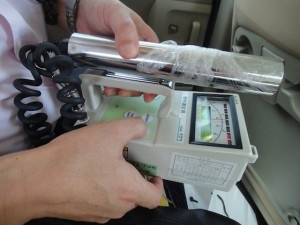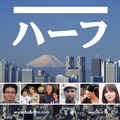In September I had the opportunity to visit Fukushima City, Japan, as a guest of Takayuki Takahashi, Vice President of Fukushima University. I first met Professor Takahashi in June, when he and his team of researchers attended a medical trade show in New York City. Almost as much as he wanted to promote the school’s medical invention, he wanted to promote the resilience of Fukushima residents after the horrific earthquake and tsunami of March 11 set off a nuclear crisis. When I contacted the professor in August to let him know I was going to Japan, he asked me if I would consider spending a day in Fukushima to see the “normal daily life.” This piece is a summary of my ten hours in an area that is anything but normal.
On a warm and humid Friday afternoon in mid-September, I boarded the Tohoku Shinkansen (bullet train) in Tokyo and traveled 148 miles to Fukushima City. When Professor Takayuki Takahashi and two colleagues met me at the train station, he told me the itinerary for the day.
Throughout the day I would observe normal life in Fukushima, visit a junior high school and a kindergarten affiliated with Fukushima University, and find myself in the middle of a government-declared nuclear “red zone.”
Then Professor Takahashi pulled a sievert meter from a Godiva chocolate shopping bag. Looking as if it belonged in a Sci-fi movie, this device measures microsieverts (µSv), the units of radiation absorbed by the body. I would soon learn that carefully monitoring radiation levels has become the new normal in communities surrounding the stricken Fukushima Dai-ichi Nuclear Power Plant.
Professor Takahashi is not a nuclear specialist, but rather he’s a member of Fukushima University’s faculty of Symbiotic Systems Science, where he specializes in the field of robotics. I’m not a scientist, but I wrote a story about the robotic medical invention the professor and his team presented at the Medical Design and Manufacturing East Exposition (MD&M East) at the Javits Center.
When Takahashi was in New York, he wanted to show that, three months after a 9.0-magnitude earthquake triggered a massive tsunami and unleashed a nuclear crisis in Japan, the area – and even the nation – was moving toward recovery.
Almost six months after March 11, Professor Takahashi is still conveying that message.
I was in Japan to cover and participate in the JapanBall tour, attending five professional baseball games in five different cities. I routinely e-mail friends and colleagues before a visit to Japan, and since I was impressed by Professor Takahashi during our initial meeting, I decided to reach out to him.
“How about visiting Fukushima and feeling the real situation of us?” Professor Takahashi asked in an e-mail to me when I told him I would be in Japan. “ . . . Once you get off the train and exit the station, you will see our quite normal daily life.”
A few of my Japanese friends who live in America had advice ranging from “Don’t go” to “Go, but don’t eat anything” in response to Professor Takahashi’s invitation. Considering the offer a special opportunity to see first-hand how things have (or haven’t) changed in the beleaguered prefecture, I accepted with curiosity, enthusiasm, and mild trepidation.
“You can’t really say you have a ‘normal daily life’ when you check radiation levels every day,” I said to Professor Takahashi, gesturing toward the radiation-measuring apparatus.
But in a way he was right; at first glance, things did seem normal in Fukushima City. People were out and about, going to work, riding bicycles, shopping for groceries. I saw no signs of damage from the March 11 earthquake. The train station was pristine, the roads were clear, and the buildings – save for really old ones that bore cracks – looked stable.
But Professor Takahashi reminded me, “We didn’t get earthquake damage, just the problem with radiation.”
Oh yes, radiation. It can’t be seen or felt or tasted. But it can be measured, and the professor checked the readings on his sievert meter throughout the day like a businessman checking his smart phone. “Radiation occurs naturally,” Professor Takahashi explains, “and a normal reading is 0.05 µSv.” That day’s reading at the Fukushima City train station: 0.07 µSv.
The first stop on my tour of Fukushima was a junior high school. We were shown around by Eiichi Saito, principal of the junior high school, and Kyoko Hamajima, the director of the adjacent kindergarten. It seemed as if the students had settled into a normal routine of attending classes. Student teachers were being graded on how they conducted their lessons. Shoes occupied their usual spots in cubbyholes placed throughout the buildings. Bulletin boards sprang to life with colorful messages about upcoming activities.
Despite appearances, something extraordinary happened here, and things are not completely normal. Of the 480 students enrolled at the school, eleven withdrew because their families relocated to different cities due to radiation concerns. When cesium-137 was detected in the top five centimeters of soil on school grounds, officials buried the contaminated soil five feet underground.
Cesium-137, a product of the fission of uranium and plutonium, was released into the atmosphere during the accident at Fukushima Dai-Ichi Nuclear Power Plant on March 11. Particles from the fallout settled in Fukushima City, 50 miles away.
Principal Saito gave us a tour of the grounds and showed us the fenced-in square of land containing the buried soil. During the decontamination process, the affected soil was covered in mid-May with dirt brought in from Shiroishi, a town in Miyagi Prefecture 20 miles to the north, Saito says. Elsewhere at the school, a swimming pool – filled with water – sits unused. The swim team’s training was suspended due to safety concerns from parents.
Unlike in the United States, the Japanese school year begins in early April. The Japanese government deemed Fukushima City safe enough for area schools to open on April 8, five days later than schedule and less than one month after the disaster.
When asked if she felt safe with the government’s decision to open the school in April, Hamajima hesitated, saying it was “a difficult question” to answer. “Of course, I agree with the government’s ruling that the school was safe enough to open,” she continues, but in the back of her mind, “I felt concern for the young children.”
It is important to Hamajima to have a consensus among the parents of her kindergarten students where safety issues are concerned. Since the onset of the nuclear crisis, the kindergartners have played in the gymnasium rather than outside. Months later, when Hamajima proposed that it was safe for the children to play outdoors, all but five parents agreed. Since there was no consensus, the children continue to spend recess indoors.
The radiation levels outside the kindergarten that day: 0.20 µSv. (The reading at the train station where I arrived a few miles away was 0.07 µSv.)
*This article was originally published in JapanCulture•NYC on October 31, 2011.
© 2011 Susan Hamaker








